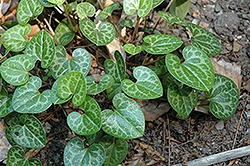It's all about ...
plants

Woodlander's Select Alabama Wild Ginger
Asarum speciosum 'Woodlander's Select'
Height: 6 inches
Spread: 6 inches
Sunlight:
![]()
![]()
Hardiness Zone: 6a
Description:
A rare and easy to grow native evergreen producing unusual flowers that are sure to add tremendous interest to the garden; attractive variegated foliage for the rest of the season; great for the shade garden or containers
Ornamental Features
Woodlander's Select Alabama Wild Ginger's attractive glossy heart-shaped leaves remain forest green in colour with showy gray variegation throughout the season on a plant with a spreading habit of growth.
Landscape Attributes
Woodlander's Select Alabama Wild Ginger is an herbaceous perennial with a ground-hugging habit of growth. Its relatively coarse texture can be used to stand it apart from other garden plants with finer foliage.
This is a relatively low maintenance plant, and should not require much pruning, except when necessary, such as to remove dieback. Deer don't particularly care for this plant and will usually leave it alone in favor of tastier treats. It has no significant negative characteristics.
Woodlander's Select Alabama Wild Ginger is recommended for the following landscape applications;
- General Garden Use
- Groundcover
- Naturalizing And Woodland Gardens
Planting & Growing
Woodlander's Select Alabama Wild Ginger will grow to be only 6 inches tall at maturity, with a spread of 6 inches. Its foliage tends to remain low and dense right to the ground. It grows at a slow rate, and under ideal conditions can be expected to live for approximately 10 years. As an herbaceous perennial, this plant will usually die back to the crown each winter, and will regrow from the base each spring. Be careful not to disturb the crown in late winter when it may not be readily seen!
This plant does best in partial shade to shade. It requires an evenly moist well-drained soil for optimal growth. It is not particular as to soil pH, but grows best in rich soils. It is quite intolerant of urban pollution, therefore inner city or urban streetside plantings are best avoided, and will benefit from being planted in a relatively sheltered location. Consider applying a thick mulch around the root zone in both summer and winter to conserve soil moisture and protect it in exposed locations or colder microclimates. This is a selection of a native North American species. It can be propagated by division; however, as a cultivated variety, be aware that it may be subject to certain restrictions or prohibitions on propagation.
This plant is not reliably hardy in our region, and certain restrictions may apply; contact the store for more information.
